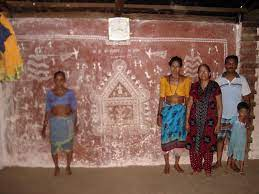TRIBE OF INDIA : WARLI TRIBE
≪•◦ ❈ ◦•≫WARLI TRIBE ≪•◦ ❈ ◦•≫
The Warli or Varli are an Adivasi tribe from western India who live in mountainous and coastal locations along the Maharashtra-Gujarat border and nearby areas. They have their own animistic beliefs, lives, customs, and traditions, and they have acquired many Hindu ideas as a result of acculturation. The Warli speak the unwritten Varli language, which belongs to the Indo-Aryan languages' southern zone. They are widely known for their art which is called 'Warli paintings' as everyone knows.
The name Warli comes from the word Warla, which means "field" or "land." Agriculture and related activities are their primary occupations. The Warli tribes are an Indian scheduled tribe that live primarily in the talukas of Nashik, Thane, and Dhule districts of Maharashtra. They can also be found in Gujarat's Valsad district and Indian Union Territories. They have their own animistic beliefs, lifestyles, traditions, and customs. They have embraced numerous Hindu beliefs as a result of acculturation.
The women of this region dress in a Lugda (लुगडं) that is worn until the knee and is usually a one yard saree. The knee-length draping resembles the Maharashtrian saree draping style. To conceal the upper half of their body, they use a loin cloth draped like a padar (पदर) or pallu (पल्लू).
To show their culture, the men wear a loin cloth, waistcoat, and turban. In every manner, the style is unique, tribal, and simplistic.
FESTIVALS:
The Warli tribal people celebrate Diwali, the festival of lights, with tremendous zeal, and refer to it as 'Barash.' There are additional holidays that this tribe celebrates with tremendous joy. These Warli tribes also participate in the Bhawada celebration. After the harvesting season, people also celebrate Kali puja. Dhumsa, Gauri, Kambadu, Tarpa, and Dhol dance are just a few of the colourful dance forms that showcase their traditions.
FOOD HABITS:
The Warlis mainly have a non vegetarian diet. They eat deer, goat, wild rabbit, birds, pigeons, and peacock meat, although fish is the most popular non-vegetarian cuisine. Dry fish is combined with dal (lentils) or vegetables and served with rotlas (thick breads of nagli, wheat, jowar or rice). Nagli and rice are staple foods. Chutney is served with rice. Their diet includes urad (green gramme), tur (pigeon pea), and gramme pulses. Breakfast is made up of rice-gruel. In addition to tubers, spinach, and a variety of leafy vegetables, vora wild roots are consumed during the winter season. Palmoline and groundnut oils are used by the Warli in the preparation of food. They make mahua and molasses-based liquor for their own enjoyment and to sell to others. They occasionally ingest seasonal fruits obtained from the wild. Due to the scarcity of milk, using it to make tea is quite limited.
MARRIAGE:
In their community, marriage is the most important rite. Girls marry between the ages of fifteen and seventeen, while guys marry between the ages of seventeen and nineteen. The ceremony usually lasts four to five days. The Warli paintings are usually done at the wedding ceremony and are referred to as "Lagnacha chauk" or "marriage paintings." The painting is sacred, and the wedding cannot take place without it. Kali ganthi (black thread necklace) and kanku (vermilion) in the hair parting are emblems of a wedded woman. In marriage, the bride receives a new set of clothes as well as some jewellery.







Comments
Post a Comment